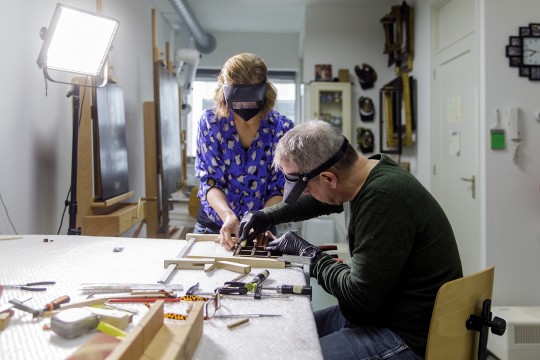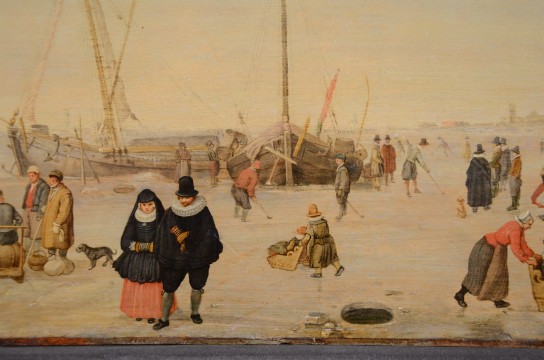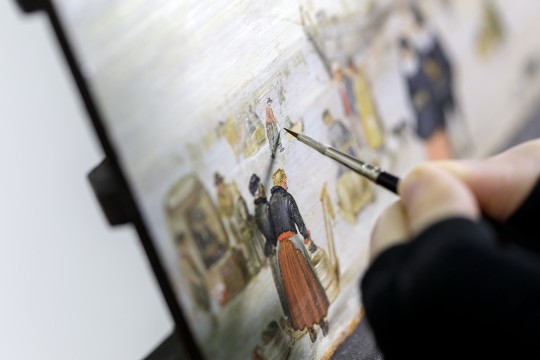

New details come to light during the restoration of Hendrick Avercamp’s painting Scene on the Ice
During the past year, Hendrick Avercamp’s painting Scene on the Ice has undergone a thorough restoration, bringing to light new details and revealing the work’s original colours.
The clean-up has made the reflections of the figures in the foreground clearer and, most importantly, has made it clear what is really going on in the background. To the left of the boats is a group of vertical ochre lines. Initially the restorer, Johanneke Verhave, interpreted this as a clump of reeds, until she realised that it is, in fact, a gallows field with ten hanging corpses. It also became clear that various figures are staring at the bodies and that the three horse-drawn sledges are taking people to view this grisly attraction. This discovery may help locate the spot Avercamp painted in this scene. Many of his paintings feature a gallows field, something that was typically located outside the city walls.

Radical treatment
Restorer Johanneke Verhave: ‘The painting required radical treatment. The removal of the old varnish layer has significantly increased its brightness but also revealed that there was much more old retouching than was visible through the thick layer of varnish. With the choices made during the new retouching, the painting is now much closer to how Avercamp intended it.’
The first step in the restoration was to treat the back of the painting. A so-called cradle, comprising vertical and horizontal slats, had been installed in the past to keep the wooden panel flat. The slats must be able to move but this was no longer the case. The first step was therefore to unblock the cradle to reduce the stress on the panel.




Removing the varnish layer and 'retouch'
Then the restorer turned her attention to the front of the panel. The painting had a very old, thick and discoloured layer of varnish, which the restorer removed. After removal, the colours appeared much brighter, but it also became apparent that more paint had been lost from the painting in the past than could be estimated before the varnish was removed. The restorer therefore had to ‘retouch’ the areas of lost paint, making the image legible again by reconstituting it in a well-considered and minimal way.









After removing the varnish layer and the old overpainting, the restorer discovered new details in the work. Although past restorers had worked carefully, they had consciously or unconsciously changed certain details. For example, the curled ends of some of the skates had been painted out, as had the tip of the hooded cape worn by the lady in the foreground.

When dealing with the right side of the painting, other problems emerged. Some figures had been added later, one man turned out to be a woman and other figures had been painted out. Another figure is only half visible, which suggests that the panel has been sawn at this point, and that the painting was originally slightly larger.
When the restoration was complete, the painting was varnished, and the work was framed again.

The restoration before, during and after




The restoration on video
When the restoration was complete, the painting was varnished, and the work was framed again. We captured some steps in the restoration process in the video below. Restorer Johanneke Verhave explains what is involved in such a thorough restoration and what choices she is faced with during the process.
Fascinating details in the freezing cold: refreshments
Here Avercamp has painted the typical refreshments known as “koek en zopie” (pancakes and mulled beer) served on the ice in the seventeenth century. The woman is preparing two pancakes on the brazier, next to which is an earthenware pot filled with batter. The woman with the red skirt in the foreground with a bucket on a sledge, a red earthenware pitcher and drinking vessels provides a warming drink for the skaters.

Fascinating details in the freezing cold: Children in a sledge
The two well-dressed children in the sledge are kept warm by a small brazier placed between them. The girl puts her green mitten on it to warm her hands.

Fascinating details in the freezing cold: barrel with inscription
The sledge the children are sitting in bears the monogram ‘HA’ in grey paint: these are the painter’s initials. It is less obvious that the letter H is inscribed on the barrel on the sledge on the left.

Fascinating details in the freezing cold: an accident on the ice
Many of Avercamp’s winter scenes feature skaters who have fallen on the ice. While not very prominent in this painting, a man and woman who have fallen over can be seen sitting on the ice on the far right. The man appears to be rubbing his head: his hat has come off and is on the ice to his left.

Hendrick Avercamp and the Little Ice Age
The last quarter of the sixteenth century was one of the coldest periods in northern Europe’s history and is therefore known as the Little Ice Age. During the winters, many rivers and lakes froze sufficiently deeply to support skating, which became a popular pastime among people of all ages and social classes. Avercamp went on long skating trips in his youth. He was both deaf and mute but was determined to become a painter. In the winter, he loved to sketch the landscape around his hometown of Kampen and to make studies of the attitudes, actions and interactions of the people on the ice. He later used the sketches to develop detailed drawings or paintings in his studio. He sometimes re-used certain figures, which appear in several of his works. Avercamp’s ice scenes were popular during his lifetime for the sense of fun and the zest for life exhibited by the varied figures that populate them. His winter landscapes were famous far beyond the Netherlands and it was largely thanks to Avercamp that the ice scene was ultimately elevated to an independent and specialist genre within painting.
Now on view in 'Maritime Masterpieces'
Avercamp's restored Scene on the Ice is currently on view in Maritime Masterpieces in the Maritime Museum, the last exhibition in the series ‘Boijmans Next Door’. The exhibition merges art history and maritime history, combining sublime seascapes from the sixteenth to the twenty-first centuries from the collection of Museum Boijmans Van Beuningen with model ships and other items from the collection of the Maritime Museum. The artists range from famous Golden Age marine painters such as Willem van de Velde the Elder to nineteenth-century masters such as Claude Monet and contemporary artists such as Bas Jan Ader. The paintings depict rough and calm seas, naval battles, river and harbour views and ships stuck in the ice.
More about Maritime Masterpieces
With thanks to
The restoration of Hendrick Avercamp’s Scene on the Ice was made possible by Stichting Droom en Daad as part of ‘Boijmans Next Door’.

